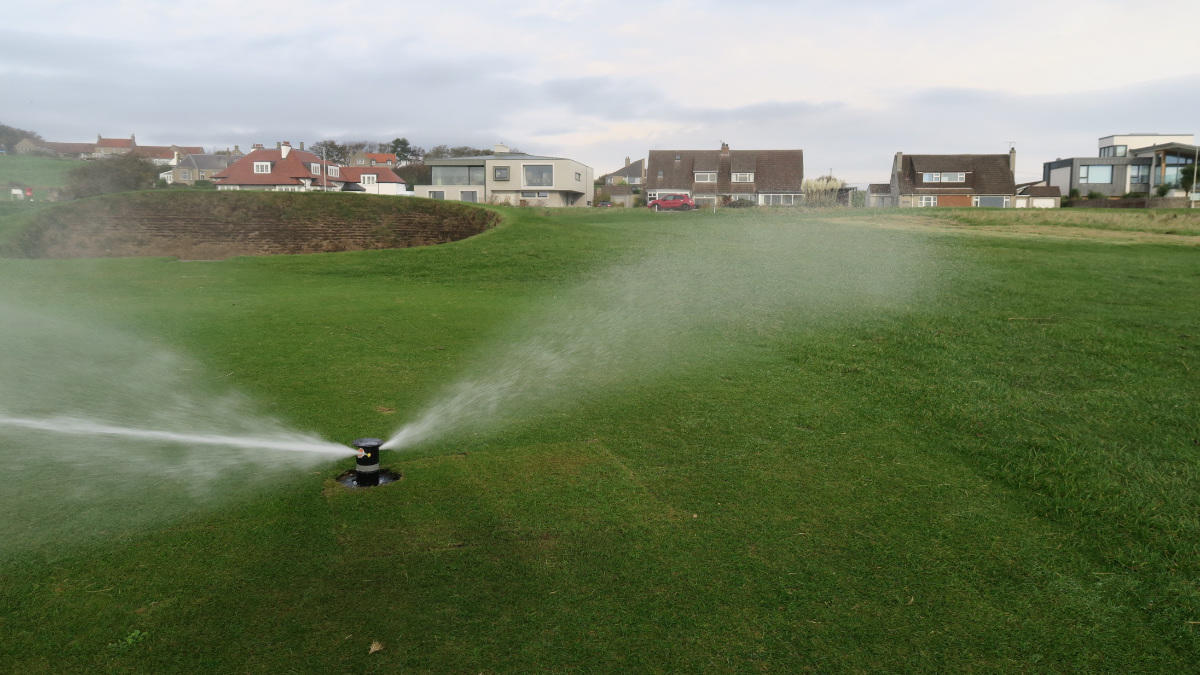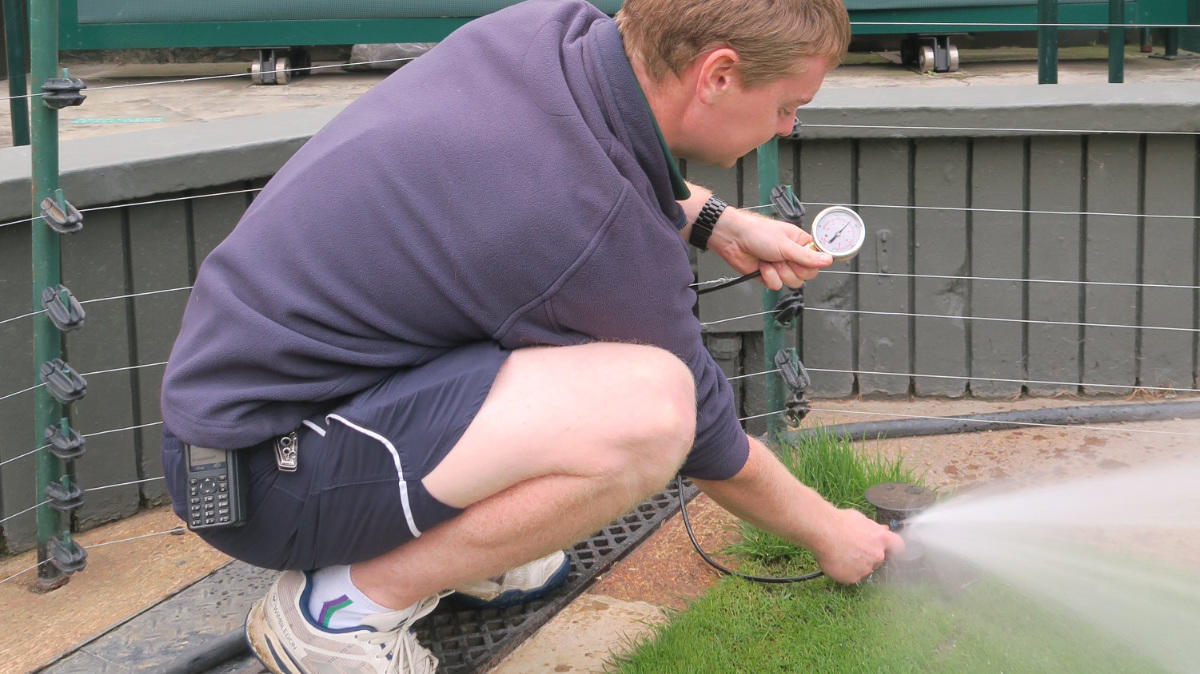- Homepage
- News and Features
- Evaluating your irrigation system
Evaluating your irrigation system

As I sit at my desk beginning to write this article, my wife has just left the house for another 12‑hour shift on the COVID‑19 wards at the hospital here in Norwich as lockdown measures are slowly being eased across all our nations.
This year has seen the hottest and driest May since records began, where we had evapotranspiration rates recorded at over 6mm per day in parts of the UK and little or no rainfall. I am already hearing of irrigation winter storage reservoirs on golf courses that were full at the beginning of March nearly half empty.
All of this is off the back of the wettest winter since records began, with rainfall figures in February alone 200% above average in most parts of the UK. I am a believer, however, that nature always has a way of correcting itself and this seems to be expressing itself with more extreme periods of wet and dry. Is the new normal becoming more prolonged wetter and dryer periods?
It may seem a paradox that this change in weather patterns will in fact likely increase our need for irrigation rather than decrease it. We will need our practices on the golf course to be more resilient and efficient, using the maintenance tools available to ensure we can see ourselves through these periods. An irrigation system is just one of these tools. In this article we shall focus on how you can evaluate your own irrigation system with a view to improving water use efficiency.
Irrigation really is often a case of out‑of‑sight out‑of‑mind, which is sad considering it is the most expensive single item of maintenance equipment on any golf course.
There are four major steps to increase efficiency:
- Prepare an objective analysis of each component of the whole irrigation system;
- Record any problems, existing or potential, and check the conformity with current standards;
- Assess each component as to their efficiency, both in the field and economically;
- Compile a programme and schedule of work to be undertaken, involving monitoring of both cost and allowing for increased efficiency.
Having decided to prepare an evaluation, there are several components within the irrigation system which require attention:
- The hardware components of the system. This includes water resourcing and its storage, power resourcing, pumping plant and transfer pumping systems, main line and lateral pipe work, control systems and associated cabling, isolation and solenoid valves and sprinklers;
- The operation and use of the system;
- The soil structure and turfgrass rootzone, identifying such factors as levels of compaction, » infiltration rates and actual rooting depth of the sward;
- Finally, it is necessary to identify the component species of grass present and decide on the desired future composition of the sward.
Taking each of the above in turn, let us consider where improvements and efficiencies can be achieved.

Checking sprinkler operating pressures with a pitot gauge
Does your water source and storage provide sufficient capacity during periods of dry weather? Are you making the most efficient use of electricity supplies? Does your pumping plant still provide the desired operating pressure to which the irrigation system was originally designed? Does your central control system operate efficiently ensuring accurate irrigation scheduling? Do your sprinkler spacings, flows, pressures, and radius of throw match manufacturers’ standards?
In this regard, sprinkler spacing must allow for head‑to‑head contact as over spacing will cause poor distribution of water. To achieve this, the system must be operating at optimum pressure and the correct sprinkler and nozzle should be installed. Over time greens may change shape: they may be enlarged to accommodate more pin placements, aprons may be improved and become an integral part of the green, extra sprinklers may be added.
But do they conform to the original design of the system and does the original design allow for extra capacity? If the answer is no then these additions to the system, these ‘improvements’, may in fact be degrading the whole system.
Sprinklers incorrectly installed will deliver uneven precipitation, resulting in excessive wet or dry areas. Sprinklers should also be selected to allow the correct arc setting and prevent excessive overthrow. The pattern of irrigation and areas to be irrigated should be a major consideration in your overall plan.
In your review of the system it is essential that you record the principal areas the club wish to irrigate: is it to be greens and tees only, or will aprons and surrounds be required? Maybe there will be a need for fairway irrigation in the future and if so, forward planning is essential, with increased pipe size considering a future increase in water capacity and requirements.
Arc settings and providing flexibility in control are critical in design. To change from irrigating the greens putting surface and surrounds with a single sprinkler on full circle to irrigating the greens putting surface and surrounds using two sprinklers (back‑to‑back) operating part circle with opposing arcs (say each at 180 degrees) will allow for finite control and a likely reduction on the overall water budget, provided the operating time of the sprinkler is summarily reduced. Where surrounds need to be watered, the use of back‑to‑back sprinklers in critical areas enables different quantities of water to be applied to the greens putting surface and surrounds and prioritising where water is applied during prolonged dry weather.
Pipe work integrity can be checked with relative ease by monitoring water lost in the system when it is at rest, provided that a water meter is installed – this is a simple monitoring tool that is a must for all clubs. Leakage from a damaged joint or split in the pipe can account for significant losses. A series of damaged pipe work joints leaking 10 litres per minute, for example, will waste 14.4 cubic metres per day and just over 3,000cu.m from April to October. This may represent a loss in the region of £3,000 per year, depending upon your water source.
The efficiency of the pumping system itself depends upon the correct selection and type of pump, pipe work, method of control and most importantly how well it has been maintained over the years. Individual pump impellers will wear, reducing operating pressures and performance throughout the system. Modern pump stations should also use ‘variable frequency control’, which enables a reduction in power consumption, wear and tear on the pump (and irrigation pipe work) and will only deliver the amount of water required by the system at any one time.
Finally, the irrigation central control system should be checked to ensure that all stations out on the course operate electrically and are capable of being individually programmed with their correct precipitation rates to allow for operation in millimetre application rather than time.
The central control software should be checked for correct data input, including spacings, nozzles, operating pressures, and sprinkler type. It should also be capable of ‘repeat-soak’ cycles to enable sufficient infiltration in poor or hydrophobic soils and allow easy alteration of irrigation schedules to adapt to our varying weather.

Checking soil moisture
Correct operation and timing of irrigation application is paramount in the efficient use of an irrigation system.
Calculation of accurate sprinkler precipitation rates and associated operating time is critical. The amount of water required depends on the evapotranspiration rate, usually between 2.5mm and 5mm per day dependent upon solar radiation, wind and temperature, of which typically between 50‑60% is applied as irrigation. This can be delivered by natural precipitation but if levels are significantly below evapotranspiration, irrigation will be required.
Depending upon sprinkler set up, the operating times will vary. It is a fallacy to blandly say, “I operate my sprinklers for 10 minutes”, as 10 minutes on full circle will deliver only half the precipitation as 10 minutes at half circle.
Sprinkler application rates must also be matched to infiltration rates and if the application rate exceeds the infiltration rate, ponding and surface run off will occur, wasting water. A ‘repeat-soak’ scheduling cycle is preferable.
Knowing how much water to apply was attained traditionally by maintaining a water balance sheet, which is in effect a profit and loss account balancing the loss (evapotranspiration) and the profit (natural precipitation and irrigation). Excess evapotranspiration over rainfall creates a deficiency, a » percentage of which is replaced by irrigation. The point at which irrigation will be required depends upon the available soil moisture. It is not essential, in fact it is detrimental, to constantly lift the soil water to field capacity as some degree of soil moisture deficit is required to allow for future natural precipitation. The water holding capacity of a soil or rootzone depends upon the soil type and the available capacity will depend upon the depth of rooting of the grass.
Observation and analysis of the rootzone using a soil moisture meter, along with the installation of a weather station, should provide many answers to the successful and efficient management of water.
Provision of a compaction free rootzone by both surface and sub‑surface aeration techniques will contribute to a deeper rooting sward and greater root biomass. A weather station, whether computer linked or not, will provide accurate data on both evapotranspiration and rainfall, enabling the provision and maintenance of a water balance sheet. The use of soil monitoring equipment for moisture deficits and volumetric content or salinity levels, whether standalone or linked into the central control system, are now essential elements to ensuring efficient use of water.
The use of wetting agents can also play a significant role in the efficient infiltration and use of water, as can the role of plant growth regulators.
In conclusion, while carrying out irrigation system evaluations, we now see many that are well past their use by date – the average lifespan of an irrigation system being 25 years, depending upon how well it has been designed, installed, maintained, serviced and upgraded throughout its life. To replace, or not to replace, is never a simple question. The solution usually lies in the choices available, which need to be looked at in the short, medium and the long term.
Be proactive, rather than reactive, in your thinking and ensure you plan ahead so you may not need to do everything at once.
Water will never be cheap and will inexorably increase in cost – indeed potable water may even be denied in the future – so it is imperative we use water efficiently. How can we plan our water usage for the future?
- Follow best practice in cultural maintenance
- Ensure, as far as is reasonably possible, water sources and storage can deliver the quantities required during dry periods of weather
- Appraise the core elements of the system, such as water storage, pumping plant, pipe work, valves and control system to ensure efficient, reliable operation
- Clearly identify the areas to be irrigated and ensure the irrigation system can deliver to those areas.
- Check sprinklers are positioned and working efficiently with correct spacings, operating pressures and nozzles and calculate accurate irrigation precipitation rates and run times
- Utilise a weather station and soil moisture monitoring equipment to aid with accurate irrigation scheduling
- Consider alternative sources of water
- Continue the conversation:
@AdrianMortram
Author

Adrian Mortram
https://www.irrigationconsultants.co.uk
